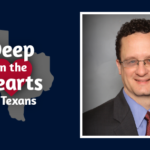• The BaptistWay lesson for Dec. 1 focuses on Luke 5:12-26.
Healing as holistic
We go to the doctor in a similar manner that we take the car to the mechanic. Our purpose is functional. We want our symptoms treated so we can go on living our lives. The physical healing we seek from medical personnel has little to nothing to do with the way we live our lives afterward.
When we do allow our health to affect the way we live, it often is viewed as an unwanted obligation. Diabetics sorrowfully abstain from sugar; heart patients begrudgingly avoid fried foods; and the obese diet and exercise in hope of dropping weight.
Jesus’ healing is presented as holistic in the Gospels, particularly in the book of Luke. The Great Physician is not a doctor who heals people so they can be on their merry way; but rather, one who heals physically with the intention of transforming spiritually. We see this in Luke 5:12-26 in two healing episodes that follow a similar pattern: 1) Jesus performs a physical healing and 2) the subject of the healing glorifies God.
Leprosy healed (5:12-13)
The leper Jesus heals in the first episode must have had some kind of knowledge of Jesus’ previous miracles. He falls at Jesus’ feet with his face to the ground in shame and uncleanness. Much like us at the doctor’s office, he is seeking a physical fix. The title “Lord” he uses to address Jesus is more like an official greeting than any kind of recognition of messiahship. The guy just wants to get well.
If you’ve ever struggled with a medical condition several doctors failed to treat, you can relate. It is not common for people to hop from one doctor to the next in hope of a correct diagnosis and cure when facing a troubling ailment.
We are left to wonder about the leper’s past and the many failed attempts at healing or downright refusals for care he must have faced. “If you are willing, you can make me clean” he tells Jesus. “I am willing,” Jesus said.
Sign up for our weekly edition and get all our headlines in your inbox on Thursdays
A command to testify (5:14-16)
The leper had no idea his willingness would turn into a testimony. Jesus offers no magic spells or ceremonial cleansing. At his direct command, the leprosy immediately is cured. This is where our connection to a doctor ends.
We might come back for a follow-up, be instructed to take a pill at home or refer a friend to a doctor we are pleased with. The leper, however, follows Christ’s command to testify to the priest about his cleansing. Perhaps without even fully knowing about it, he is playing a part in God’s plan to share Jesus’ identity with the religious establishment.
The paralytic (5:17-20)
The paralytic healed in the second episode is brought to Jesus through the effort of his friends. They were forced to enter the house where he was teaching through the roof due to the large crowds blocking the doorway. This would have been just as unconventional then as it is now, but ancient roofing material could be separated without being damaged. Perhaps you’ve attended a benefit or fundraiser hosted by friends and family members of a person stricken with cancer or some other costly and debilitating diagnosis. A
ll the effort put into these kinds of events is periphery. Music, food and entertainment might be included, but the goal is healing. The same was true behind the antics of the paralytic’s friends. They wanted him to be healed and were willing to do whatever it took.
A command to walk (5:21-26)
Jesus initially causes a spark when seeing their effort by pronouncing the paralytic’s sin forgiven. He is concerned with more than just his physical well-being. “But [so] that [they] may know that the Son of Man has authority on earth to forgive sins …” (v. 24). Jesus follows this spiritual healing with a physical one. Just as Jesus commanded the leper to be healed, he told the paralytic to walk. As he obeys and goes home praising God (v. 25), his actions serve as a second testimony of Jesus’s identity.
Neither the paralytic nor the leper approached Jesus with a desire to be spiritually healed. They simply wanted to be fixed. Jesus responds with the healing they requested, as well as a task that puts them in the center of the spiritual activity of the Gospel of Luke. I’m often asked if I believe healing takes place today. I do. I’ve never seen it happen instantly like it did upon Jesus’ command, but I’ve seen it happen when requested in prayer after doctors had given up hope.
As wonderful and mysterious as this kind of healing is, it is peripheral. Jesus desires to do more than heal our bodies. He wants to save us from a life of sin and redeem the purpose of our existence to fall in line with what he is doing in our world.
In what way might you need to be open to Jesus’s holistic healing today?













We seek to connect God’s story and God’s people around the world. To learn more about God’s story, click here.
Send comments and feedback to Eric Black, our editor. For comments to be published, please specify “letter to the editor.” Maximum length for publication is 300 words.